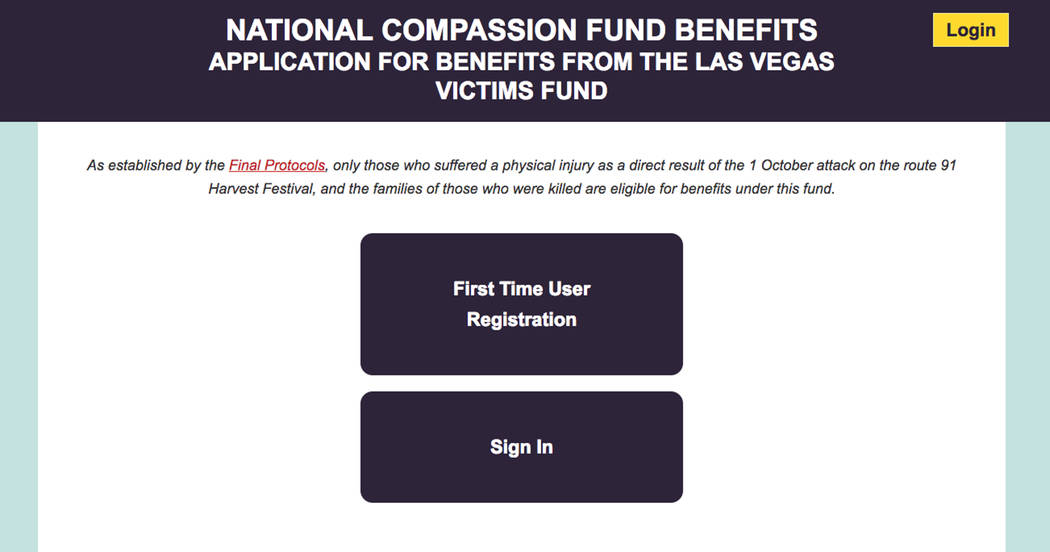Victims of Las Vegas shooting can apply for aid from fund
Those eligible for money out of the Las Vegas Victims’ Fund can now apply.
A link to submit an online claim form became available Tuesday morning at lasvegasvictimsfund.org and at benefits.nationalcompassionfund.org. Claims will be accepted from Jan. 2 until 11:59 p.m. PST on Jan. 31.
More than $22 million has been raised to aid victims of the Oct. 1 shooting on the Strip as of mid-December. The money will be distributed to people in three categories on a rolling basis beginning around March 5:
— Families of those who were killed in the shooting and people who sustained permanent brain damage and/or permanent paralysis resulting in continuous home medical assistance.
— People who were physically injured as a result of the shooting and first admitted to a hospital on or before Oct. 10.
— People who were physically injured as a result of the shooting and who were treated on an emergency or outpatient basis on or before Oct. 10.
The protocol outlines that only one claim should be submitted by or on behalf of each victim.
The Las Vegas Victims’ Fund is being administered by the National Compassion Fund, which is a program of the National Center for Victims of Crime, a registered 501(c)(3) charity.
What to expect
Claimants who lack access to a computer or the internet can call the toll-free claimant assistance number at 855-484-2846 for guidance on alternative filing assistance.
Applicants who use the online form will be asked to create a user name and password to access the system. This will allow them to complete parts of the application, log out and later return to complete the process.
Documents needed to complete an application for death benefits are:
— A death certificate.
— An applicant’s proof of relationship to the deceased victim.
— The individual distribution plan form (available to download in the application).
— The beneficiary consent form for each beneficiary receiving benefits (available to download in the application).
— Proof of each beneficiary’s relationship to the deceased victim.
Jeff Dion, deputy director of the National Center for Victims of Crime, said the average time to complete a death application is 31 minutes.
“We had more than 20 people vigorously beta-testing the system last week,” he said. “Testers used desktops, laptops, tablets and smartphones. Devices were running Mozilla Firefox, Microsoft’s Internet Explorer, Google Chrome and Safari. Testers were lawyers and lay people with a variety of technology comfort levels.”
A Health Insurance Portability and Accountability Act release authorization form (available for download in the application) is needed to complete an application for injury benefits.
If the person completing the application is applying for benefits for an injured victim who is younger than 18 years old or is unable to complete the application due to their injuries, it will be necessary to submit documentation of the relationship between the applicant and the victim. For example, if the injured victim is the applicant’s minor child, the child’s birth certificate can be submitted to prove the applicant is the parent.
Dion said the average time to complete the injury application is 18 minutes.
Contact Nicole Raz at nraz@reviewjournal.com or 702-380-4512. Follow @JournalistNikki on Twitter.
The probate process
Jeff Dion, deputy executive director of the National Center for Victims of Crime, said families of the deceased should identify a family representative for their loved one's estate, if they haven't already done so. A family representative must be authorized to apply for compensation.
"If everybody agrees on what the distribution within that family is, then we'll honor that. If people can't agree on how that should be distributed, then we're going to go ahead and send it to the probate court."
Las Vegas-based probate lawyer Jonathan Reed, with the Reed & Mansfield law firm, previously told the Review-Journal that the first step in representing an estate is to ask the probate court to name you as executor or personal representative or administrator — whichever term the decedent's state uses.
You probably will need to file an application, a death certificate and the original will (if there is one) with the local probate court in the county where the deceased person was living at the time of death.
If the deceased person owned real estate in more than one county in the same state, one probate will suffice.
If the personal representative is not living in the state where the probate is taking place, the out-of-state resident might need to appoint a resident of the probate state to serve with them as a co-administrator.

























